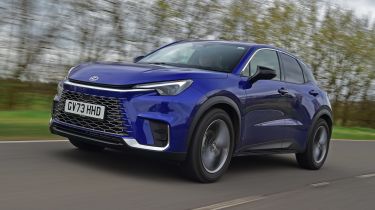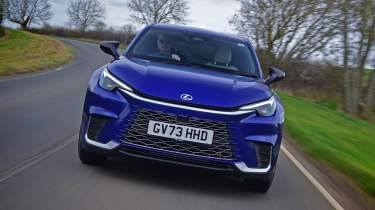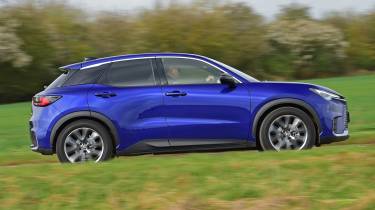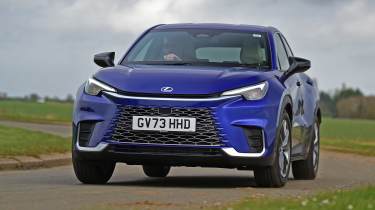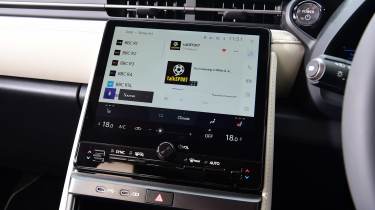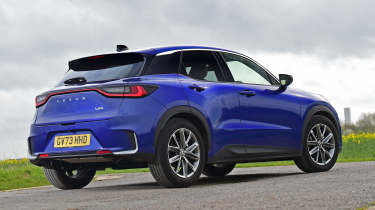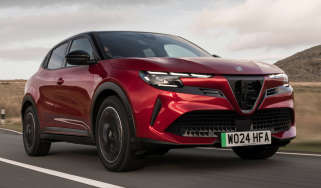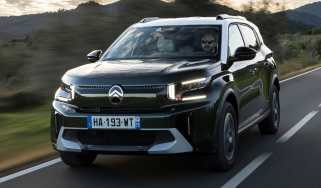Lexus LBX review - upmarket small SUV, but priced accordingly
“The Lexus LBX is a premium small SUV with the brand’s well-known qualities, but rear space is tight and it’s a little pricey”
Pros
- Nippy performance
- Comfort
- Quality
Cons
- Expensive
- Limited rear room
- An EV is even quieter
Verdict - is the Lexus LBX a good car?
There aren’t many premium models in the small SUV market right now, but the Lexus LBX brings the brand’s usual qualities to the segment. It’s attractive inside and out, well built with plenty of equipment, and is good to drive provided you’re more concerned with comfort and refinement than sporty handling. It’s expensive though, and not as spacious as some bigger alternatives that can be had for similar money. Its pricing also crosses over with some fully-electric rivals – which are even smoother to drive and cost even less to run.
Lexus LBX models, specs and prices
The Lexus LBX is the brand’s smallest model ever, and with a starting price of around £30,000, one of its most affordable too. Sitting below the Lexus UX, which is nearly £5,000 more expensive, the LBX is effectively an upscale version of the Toyota Yaris Cross small five-door SUV. It goes head to head in the market with other premium compact SUVs such as the Audi Q2 – which is nearly identical in length – and the upcoming Alfa Romeo Milano, but also higher-specification (and fully electric) versions of cars like the Peugeot 2008 and Renault Captur, along with the Volvo EX30.
The range begins with Urban specification at that £30,000 mark, with 17-inch alloy wheels, LED headlights with automatic high beam, a seven-inch digital instrument cluster, dual-zone air conditioning, front and rear parking sensors with a reversing camera, and a 9.8-inch infotainment screen.
Premium trim is another £2,500, Premium Plus a further £2,000, and top-spec Takumi trim begins at just over £38,000, each offering progressively more luxurious levels of equipment. Adding E-Four all-wheel drive to Takumi models bumps up the price by a further £1,300.
| Trim levels | Power options |
|
|
MPG, running costs & CO2 emissions
As an affordable entry point into the Lexus range you’d hope the LBX is affordable to run too, and with a hybrid drivetrain, comprising a three-cylinder petrol engine and an electric motor (or, in all-wheel drive form, the addition of an electric motor at the rear wheels), the LBX certainly totes some impressive figures in the brochure.
Officially, the LBX’s combined economy hovers around 60mpg for front-wheel drive versions, dipping into the high 50s for the E-Four all-wheel drives. Differences in the figures are down to trim level differences, with larger wheel and tyre setups and extra weight all having an impact on economy.
The LBX is what Lexus calls a ‘self-charging hybrid’ too, which effectively is the kind of hybrid that has been on sale now for quarter of a century. You fill it with fuel like a normal car, and the car then runs either on petrol power or electricity depending on driving conditions, charging and depleting a small battery pack as required.
| Model | Fuel economy | CO2 emissions |
| Hybrid | 62.7mpg | 102-108g/km |
| E-Four | 58.5mpg | 110-113g/km |
Engines, drive & performance
This is the first Lexus to feature a three-cylinder engine, as part of what Lexus calls its ‘self-charging hybrid’ arrangement that’s more familiar to the brand. The combined efforts of a 1.5-litre petrol three-cylinder and an electric motor result in 134bhp, just a little more than the 129bhp of the Toyota Yaris Cross on which the LBX is based. Lexus also says it has tuned the electric motor and its software for quicker responses. There’s also an all-wheel drive option on the top-spec models, which places an extra electric motor at the rear axle.
Performance is peppy rather than sporty, with a 9.2-second 0-62mph time, which certainly undercuts the 11.2 seconds the Yaris Cross takes, and the performance is smoother too – providing you don’t drive with your foot to the floor everywhere, as the continuously variable transmission (CVT) still allows the revs to rise quicker than your road speed. The unusual engine note isn’t unpleasant, but at a more relaxed pace, you’ll barely hear it. Lexus has put a lot of effort into boosting refinement, and the engine is much quieter than in the Yaris Cross.
Is the Lexus LBX good to drive in town?
Given smaller hybrids are typically aimed at town driving it’s no surprise to find the LBX works well at lower speeds. The ride feels firm and controlled but far from uncomfortable, with its Lexus-tuned suspension doing a better job of filtering out bumps than the Toyota. Its steering is accurate, if a little heavier than you might expect. It feels nippier than the similar Yaris Cross too, thanks to the LBX’s small increase in power, and it’ll happily run around quietly using electric power for a good proportion of your time driving around town.
Is the Lexus LBX good to drive on long journeys?
On faster roads and motorways the LBX is both composed and comfortable – it may be a relatively compact car, but it’s still a Lexus in this respect. The suspension does a good job of controlling the body’s movements and only larger imperfections in the road really make their way through to the cabin. It’s quiet too, with little engine noise and only a small rustle of wind noise from the door mirrors.
Is the Lexus LBX good to drive on B-roads?
The LBX is capable, rather than entertaining in B-road driving. It’s clearly intended to be safe rather than fun, with faithful steering responses and good grip, but not much feedback to the driver through the controls, and regular intervention from the traction and stability control systems, that encourage a gentler pace. There’s also a reasonable amount of body lean, but not so much that the car feels excessively top-heavy.
| Model | Power | 0-62mph | Top speed |
| Hybrid | 134bhp | 9.2sec | 106mph |
| E-Four | 134bhp | 9.6sec | 106mph |
Interior & comfort
The LBX makes the right first impressions, with a more upmarket look and feel than the Yaris Cross. The driver’s instrument display and the central touchscreen are both better integrated into the design and the air vent design blending into the doors is a nice touch. Materials are all high quality too, with stitched fabrics and dense foam padding. Our test car was trimmed with light man-made leather that looked premium, but we weren’t as impressed by the feel of the steering wheel.
This extends to smaller controls too – the gear selector lever has a robust, quality feel and the buttons (rather than handles) to open the doors are the kind of feature you might expect on a much larger, higher-end car. A few details let the illusion slip, but they aren’t deal-breakers.
Is the Lexus LBX infotainment and navigation system easy to use?
Lexus hasn’t always had a strong reputation for the usability of its infotainment systems, but this has slowly changed over the years and it’s now difficult to complain about the 9.8-inch touchscreen in the LBX, which is well positioned on the dashboard and has a clear, crisp display. Lexus has also avoided relegating too many functions to the screen – you still get physical heating and ventilation controls below it.
The infotainment also includes a neat feature that remembers which functions you use most often and makes them quicker to access, including some safety features you may not want to be activated for every trip. We did, however, find the touch-sensitive steering wheel controls used to adjust the head-up display a bit tricky to operate, and it’s possible to change the display inadvertently as you manoeuvre.
Is the Lexus LBX well equipped?
Even the entry-level Urban trim has most of the equipment you’ll need, getting 17-inch alloy wheels, LED headlights with automatic high beam, a seven-inch digital instrument cluster, dual-zone air conditioning, front and rear parking sensors with a reversing camera, and a 9.8-inch infotainment screen as standard, as does wireless Apple CarPlay and wired Android Auto compatibility.
Premium adds more toys, including heated synthetic leather seats and a smartphone charging pad, and Premium Plus goes a step further with a larger instrument display, powered tailgate, head-up display, and 18-inch wheels. Takumi spec tops the range, with leather seats, parking assist, 13-speaker Mark Levinson audio and more – the kind of kit you’d expect on one of Lexus’ larger models.
What options should you choose on the Lexus LBX?
Lexus doesn’t typically offer a wide range of options, instead simply setting a high standard level of equipment on its models. Both Premium Plus and Takumi trim lines do get an additional Design trim level though which gets different upholstery, a contrasting roof colour, and machined 18-inch alloy wheels. You can upgrade the alloy wheels on some models too, while some metallic paint shades are extra-cost options.
| Key features | |
|
Urban
|
Premium Plus (Premium plus…)
|
|
Premium (Urban plus…)
|
Takumi (Premium Plus plus…)
|
Practicality & boot space
While based on the Toyota Yaris Cross, Lexus has actually extended the wheelbase of the LBX – the distance between the front and rear axles – by 20mm, and it’s also 60mm wider. This promises a little extra interior space, but even so the LBX is not one of the larger and more space-orientated cars in this class, so while front passengers get a pretty good deal, foot space, kneeroom and headroom are all in short supply in the back, at least for taller adults – kids should be fine, however. It’s best to think of the LBX as a four-seater, because the middle seat is tight and only really suitable for occasional use. It’s a similar theme for interior storage, because while there’s a cubby in the centre console and front door bins, they’re all on the narrow side for larger items.
| Size comparison | |||
| Model | Length | Width | Height |
| Lexus LBX | 4,190mm | 1,825mm | 1,545mm |
| Toyota Yaris Cross | 4,180mm | 1,765mm | 1,595mm |
| Audi Q2 | 4,191mm | 1,794mm | 1,508mm |
| MINI Countryman | 4,333mm | 1,843mm | 1,656mm |
Does the Lexus LBX have a big boot?
Boot space depends on whether you opt for a front-wheel drive LBX, or one of the all-wheel drive models. There’s a reasonable 402 litres with the former, with a surprisingly deep space, but the need to package a motor under the boot floor means this shrinks to 315 litres with not quite as much depth in all-wheel drive versions. All require you to lift heavier items over a relatively high loading lip however, and aside from a few tiedown anchors in the floor, there aren’t any other hooks or attachment points at the sides to help prevent bags from falling over.
Space with the rear seats folded down is disappointing at 994 litres, compared to 1,395 litres for the more practical Skoda Kamiq. However, the Lexus does beat the paltry 904 litres offered by the Volvo EX30.
| Boot space comparison | |
| Model | Boot space |
| Lexus LBX | 315-402 litres |
| Audi Q2 | 405 litres |
| MINI Countryman | 460 litres |
| Volvo EX30 | 318 litres |
Is the Lexus LBX a good tow car?
Lexus does offer a detachable tow bar as an option on the LBX, and quotes a maximum tow rating of 750kg. It’s unlikely to be at the top of your list for towing anything other than relatively light trailers.
Reliability & safety
Lexus is a regular at the sharp end of the Driver Power survey, with the larger Lexus RX SUV finishing in third place in 2023. The Lexus UX finished mid-table in 38th place out of 75 cars, and the Lexus NX, sized between the UX and RX, was 55th. The Toyota Yaris meanwhile, which is similar underneath to the Yaris Cross (and therefore the LBX too), managed 36th place. As a brand, Lexus achieved eighth place, with strong scores for both reliability and build quality (both of which have long been key attributes of the brand), all of which are quite reassuring for potential LBX buyers.
How safe is the Lexus LBX?
The Lexus LBX is yet to be put through the violent but necessary crash-test procedures by Euro NCAP, but the similar Toyota Yaris Cross was assessed in 2021 and achieved a full five-star rating, so it’s likely the LBX will score similarly.
There is of course a wide suite of driver assistance systems that add to the car’s safety too, including pre-collision and emergency steering assist, a driver monitor, lane departure alerts (tuned to account for things like guardrails and kerb stones to prevent some issues with current systems getting confused by lane markings), road sign assist, blind spot monitors and more.
What is the warranty on the Lexus LBX?
The LBX comes with a standard Lexus three-year or 60,000-mile warranty (whichever comes first), with extensions up to 10 years or 100,000 miles provided you continue to get the car serviced at an authorised Lexus workshop.
Lexus LBX alternatives
The closest current rival to the Lexus LBX is the Audi Q2, though it’s expected to disappear from showrooms some time in 2024. By this time though you should be able to buy an Alfa Romeo Milano, the only other premium model that really matches the LBX on price – the next generation MINI Countryman and the current BMW X2 have both grown in size and now start at £40,000, lifting them clear of this most compact SUV segment.
Visit our sister site Auto Express for an alternative view on the Lexus LBX...
Which Is Best?
Cheapest
- Name1.5 Urban 5dr E-CVT
- Gearbox typeAuto
- RRP£29,790
Most Economical
- Name1.5 Premium 5dr E-CVT
- Gearbox typeAuto
- RRP£32,990
Fastest
- Name1.5 Urban 5dr E-CVT
- Gearbox typeAuto
- RRP£29,790
